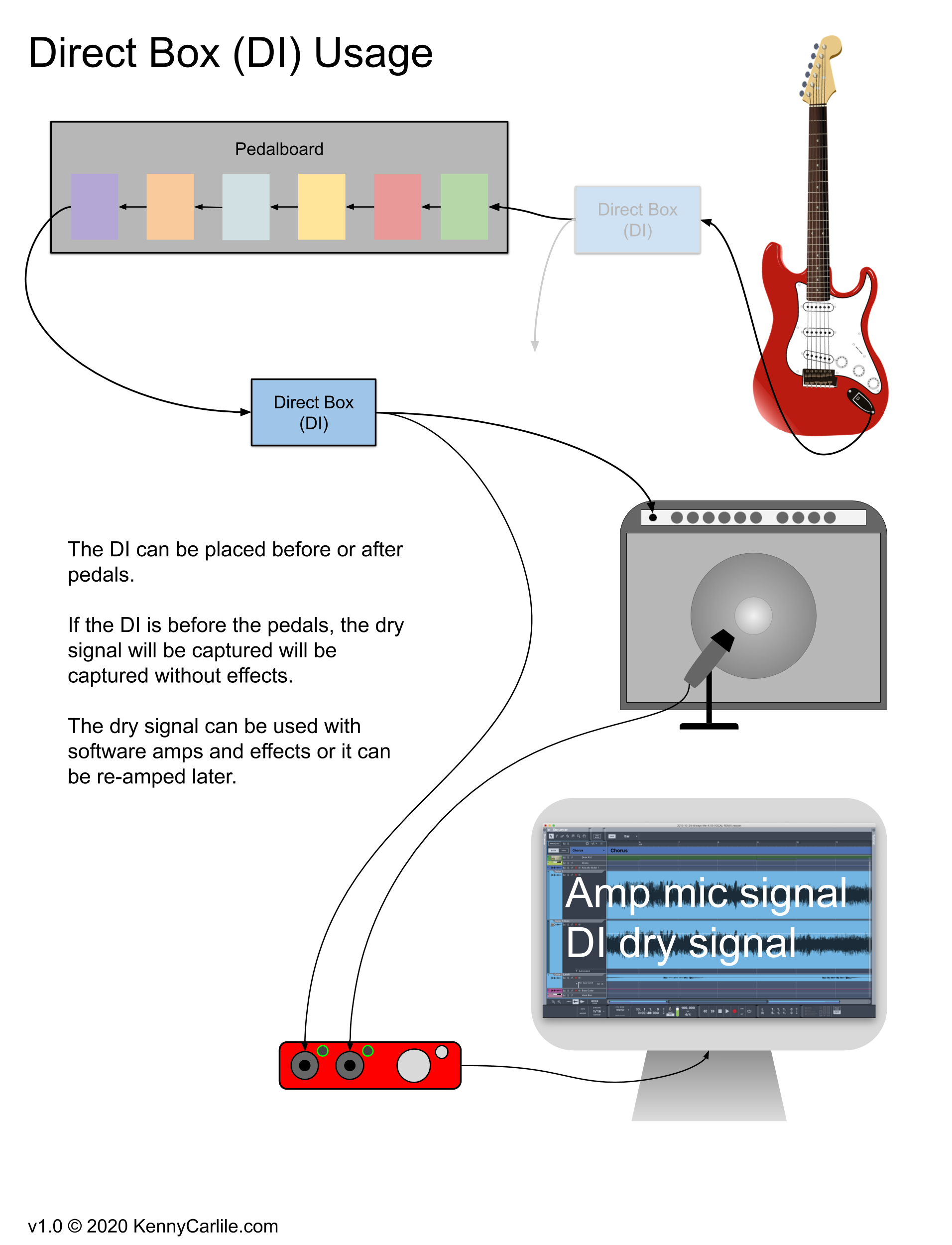I was recently talking to my kid about recording and the topic of signal flow came up. We were discussing options with regard to how to record guitar: direct into the interface with software amps and effects, through the pedalboard and then into the interface with software amps, and through the pedalboard into the amp and then mic’d and into the interface. We were talking about this in the context of recording both guitar and bass (not simultaneously). I mentioned the idea of a direct box and he said he hadn’t heard of that, so I thought I’d put together a diagram to explain the use of a direct box.
So what is a direct box?
Direct boxes are also called a “DI” which stands for direct inject. According to Sweetwater’s article on direct boxes:
…the primary function of DI boxes is to take an unbalanced, high-impedance signal and convert it to a balanced, low-impedance signal.
A direct box allows the signal to run over longer distances without degradation of quality (volume reduction and loss of high-end frequencies) and it also allows a guitar or bass signal (or other instrument) to be run directly into a microphone preamp or other similar signal processor.
Most direct boxes allow for a passthrough signal (unbalanced, instrument) and an output (balanced, line-level). In addition, many direct boxes allow for a ground lift as one of the standard features. Direct boxes are powered by 48v phantom power like a condenser microphone and the line-level output runs through a balanced cable like an XLR microphone cable.
While there are many different direct boxes on the market, the primary variations are between active and passive direct boxes. The Sweetwater article linked above does a great job of explaining the differences and why you might want one over the other.
Okay, what do I do with a direct box?
If you’re on stage or in a large recording studio, you could use a direct box to take an instrument signal and run it over a long distance to a preamp while retaining the signal integrity. But, let’s talk about the more interesting uses for recording and production.
You can use a direct box to split your guitar or bass signal to record one line directly into the recording interface and one signal into the amp. You could use the amp for live monitoring, but it’s a lot more common to then mic that amp and record it so you have a dry signal and an amped signal going to two separate tracks in your DAW. Let’s look at a few options:
Completely dry guitar in parallel
- Guitar > direct box:
- line output: recording interface
- passthrough: pedalboard > amp > microphone > recording interface
By splitting the signal right after the guitar and recording it completely dry, you have the option to either use plugins for effects and amps or you can preserve the original recording for re-amping later (see below).
Guitar with effects in parallel
- Guitar > pedalboard > direct box:
- line output: recording interface
- passthrough: amp > microphone > recording interface
Having the direct box after the pedalboard allows you to retain the effects from your pedalboard in the recording while still being able to use software amps or re-amp your signal.
Re-amping your dry signal
Re-amping is where you take a recorded guitar signal and play it from the DAW, through a re-amp box (think of it like a reverse direct box) and back through an amp (with optional effects) to be recording again. With re-amping, you can re-record the same original dry guitar performance as many times as you need to change the tone until you get it just right on the recording.
Anything else?
There are other ways to use a direct box, but these are the most common uses. The diagram below shows the “guitar with effects in parallel” flow mentioned above, but also shows the location of the direct box (faded out) if you wanted to use the “completely dry guitar in parallel” flow.
Also, bass is very often recorded as a dry DI signal in parallel with an amped signal. Those two signals are then mixed together, sometimes with software effects on the DI signal, to achieve the desired bass tone.

